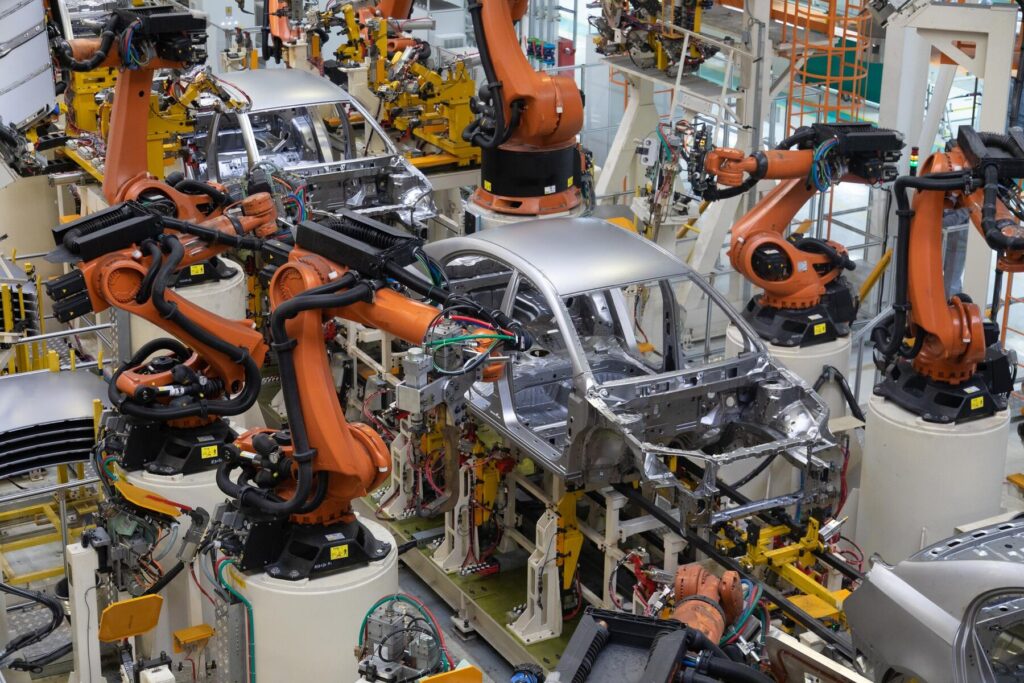Lean is a method of thinking that focuses on decreasing waste and employing fewer resources to produce the required value. An additional characteristic of lean is that it is a strategy that needs constant testing in order to produce optimal value while decreasing waste. Lean thought and practice go hand in hand with one another. On the other hand, digital lean is a concept that depicts the integration of Lean with cutting-edge digital technology such as automation and advanced analytics. This is done with the specific goal of reducing waste and improving output. For the purpose of optimising processes through the utilization of data, digital lean in production goes beyond the standard Lean methods by utilizing technologies such as machine learning and the Internet of Things (IoT). Here’s a comprehensive beginner’s guide from “Center for Lean” for a better understanding.
First, What Is “Lean” in the First Place?
Lean manufacturing is a systematic framework for eliminating waste from a manufacturing system, or value stream, without sacrificing productivity. The Toyota Production System is a prominent illustration of lean management. Two pillars support the fundamental idea of the Toyota Production System. Essentially, the first pillar, meaning “automation with a human touch,” is jidoka (自働化). It is based on the principles of increasing productivity to eliminate the need for humans to simply keep an eye on machines and to immediately halt production of defective items when anomalies are discovered. By creating just what is needed, when it is needed, and in the amount needed, the second pillar, “Just-in-Time”, is based on the idea of synchronising production processes and connecting all plants and their production processes in a continuous flow. These two pillars make it possible to produce automobiles that meet customer demands quickly, affordably, and with high quality.
What Does “Digital Lean” Mean?
Based on tried-and-true lean ideas, digital lean offers a framework for digital transformation. More importantly, digital lean initiatives can help achieve greater results than only lean or digital projects.
Without digital technology, businesses’ capacities are limited. This restriction, brought on by the lack of digital tools, increases waste overall by prolonging the time it takes to resolve problems.
For example, according to Bain, digital lean may save up to 30% on costs, compared to 15% for traditional Lean projects. Below are some benefits of digital lean and how it leads to more profitable and effective operations. In order to reduce waste and increase operational consistency, we now call this fusion of digital technology and lean principles “digital lean,” which incorporates the greatest features of both methodologies.
Key Elements of a Digital Lean Approach
1. Data-Driven Decision Making
Using facts, measurements, and data to inform strategic business decisions that support your goals, objectives, and initiatives is known as data-driven decision-making, or DDDM. Whether they are a business analyst, sales manager, or human resource professional, they are empowered to use data to make better decisions every day when firms recognise the full worth of their data. Finding the next strategic opportunity, however, requires more than just selecting the right analytical technology.
Never before has so much data been gathered, but it’s also more complicated. As a result, organisations find it challenging to handle and evaluate their data. According to a recent study by NewVantage Partners, 98.6% of executives say their company wants to have a data-driven culture, but just 32.4% say they have achieved this goal. Organisations have spent trillions of dollars modernising their businesses, yet 70% of these efforts fail because they emphasised technological expenditures without developing a data culture to back them, according to Harvard Business Review.
2. Workflow Automation
Bottlenecks are limitations or phases in the process that slow down the workflow as a whole, reducing manufacturing efficiency and lengthening lead times. These bottlenecks can appear in a variety of ways and arise at various stages of a production system. Work accumulates as a result of process bottlenecks, which occur when one stage takes noticeably longer than others. When personnel, equipment, or tooling availability becomes limited, resource bottlenecks arise, impeding efficient flow. Delays in departmental data exchange cause information bottlenecks, which impair scheduling and material flow and result in ineffective decision-making.
Automating Data Gathering for Quicker Decision-Making: Real-time insight into production bottlenecks is ensured by replacing manual data monitoring with IoT-enabled devices and AI-driven analytics, which automate data collection for faster decision-making. When a process is operating more slowly than anticipated, automated warnings notify teams so they may take quick remedial action. AI-based scheduling systems optimize resource allocation to avoid bottlenecks by dynamically distributing workloads among workstations and machines to avoid overloads. Jobs are automatically redirected to available resources whenever a machine surpasses its capacity limit, preserving a balanced workflow.
3. Real-Time Communication
Regarding digital lean, it is important to have tools that support real-time communication and teamwork to sustain the best flow of work and inspire continuous progress. Tools such as Microsoft Teams, Zoom, and Trello offer individuals the power to instantly make decisions and make it a piece of cake. These tools also double the efficiency and productivity of the company by decreasing the gap in delays in communication. Furthermore, these solutions assist with lean concepts such as decreasing waste and enhancing workflow efficiency.
Digital lean has the first place on transparency and speed without a doubt, and these tools allows your team to flag issues and assign responsibilities to each person within their group to further enhance workflow, and also the person in charge can monitor if the work is happening in a smooth manner and make proper adjustments to the work if needed. If a bottleneck is identified, the team doesn’t have to wait for professional meet and greets; the group can just point it out, ensuring everyone stays in alignment with the task.
4 . Visual Management Goes Digital
The digital kanban board is a potent new visual tool in digital lean. These resemble the classic Lean kanban boards, but they integrate cloud-based software to measure and visualize performance in real time. Managers can keep an eye on project progress from any location, and workers may transmit digital cards to document task status. Tools like Trello, LeanKit, and Kanbanize are a few examples. Managing several projects, teams, and responsibilities may easily become too much to handle. Project managers, therefore, require technologies to facilitate easier and more fluid day-to-day management.
Benefits of Going Digital with Lean
1. Faster problem solving
Most issues may be resolved much more quickly by using digital lean, which offers real-time visibility and speedier communication, as was previously mentioned. Traditional lean relies mostly on manual procedures, which can cause delays in the process of identifying a problem. In contrast, you may complete your chores much more rapidly using digital lean tools like dashboards, automatic warnings, and even mobile flagging.
Additionally, cloud-based solutions minimize delays and enable the owner, managers, and employees to work together on a project from any location, identifying and fixing problems as they arise. In addition to tools like integrated messaging systems and root cause analysis, features like digital templates may also be helpful in streamlining the problem-solving process and making it more organized and effective.
2. Better Resource Utilization
Comparing successful digital lean implementation to separate digital or conventional lean improvement initiatives, firms may anticipate cost savings and quality improvements, which will boost productivity and yield a higher return on investment With digital lean, the factory can expand on its lean foundation and harness new technologies, like as machine learning and predictive maintenance, to address previously intractable business challenges and open previously inaccessible productivity frontiers.
3. Improved Employee Engagement
With digital lean, the factory can build on its lean base and harness new technologies, such as machine learning and predictive maintenance, to handle previously unsolvable business problems and open previously unreachable productivity areas.
Digital tools are important for improving employee involvement because they offer effective and smooth routes of contact. Social media groups, intranet platforms, and team communication software are examples of tools that help employees feel like they are part of a team. These platforms enable joint problem-solving, idea sharing, and real-time feedback—all of which may greatly raise spirits and create a happy work environment.
Employee happiness may be greatly raised by using digital solutions that combine reward and honor programs. Peers and managers may recognise and reward workers for their efforts and accomplishments using platforms such as employee recognition software. As a result, employees are motivated to continue doing great work.
Digital learning and development tools help people to improve professionally over time. Organizations may ensure that their workers have plenty of opportunities to improve their skills and maintain their success in their sectors by giving them access to online courses, workshops, and training tools. Businesses should expect cost savings and quality gains when comparing successful digital lean adoption to solo digital or traditional lean improvement projects. This will improve productivity and give a greater return on investment. By using digital lean, the factory can build on its lean base and leverage new technologies, such as predictive maintenance and machine learning, to solve business problems that were previously unsolvable and open previously unreachable production frontiers.
4. More Scalable Processes for Growing Teams
A methodical strategy of improving procedures, goods, or services by gradual enhancements over time is the continuous improvement process. Software that automates the CIP can assist firms in tracking progress, identifying inefficiencies, and more successfully implementing changes. Businesses can make decisions more quickly and respond to problems more nimbly by using digital technologies to gather and analyze data in real-time. Additionally, automation lessens the amount of human labor needed, freeing up teams to concentrate on critical projects.
Real-World Examples of Digital Lean in Action
Manufacturing: IoT sensors reducing machine downtime
Smart sensors with IoT capabilities can help significantly by tackling the problem from many perspectives. They provide real-time equipment monitoring, predictive maintenance, instant alarm and diagnostics, enhanced quality control, and process optimization. Real-time performance measurements such as temperature, vibration, and cycle time were monitored by IoT sensors fitted on machines. Maintenance crews’ response times were shortened by automated notifications notifying them the moment an abnormality was discovered. Predictive analytics, when coupled with IoT equipment, can avert malfunctions and foster the improvement of maintenance plans.
Office workflows: paperless processes and automated approvals
These boards offer the patients a smooth flow of patients not occurring, as well as a visualization of all tasks to be done that is very clear. Boards help the hospital stay away from unnecessary delays as they drive the patients through different stages of their treatments. The last on the list, digital Kanban boards, not only scale up patient care, but also streamline workflow efficiency, and better coordination is achievable.
FAQs – People Also Ask Style
-
Is digital lean only for big companies?
No digital lean can be beneficial for any organization, including small businesses, hospitals, and even startups, as mentioned above. The core idea of using digital tools is not limited to large-scale manufacturers
-
What’s the difference between lean and digital Lean?
| Lean | Digital Lean |
| Focuses on reducing waste, improving flow, and increasing value | Same goals, but uses digital tech (IoT, AI, software) to enhance results |
| Uses tools like 5S, Value Stream Mapping, and Kanban boards | Uses digital versions of these tools (e.g., e-Kanban, digital dashboards) |
| Often relies on manual tracking | Enables real-time data and automation |
-
Can I use Lean tools without going fully digital?
You can apply Lean principles using whiteboards, sticky notes, and pen-and-paper value stream maps. Many organizations start this way.
How to Start with Digital Lean (Even If You’re a Beginner)
Beginning with digital lean doesn’t require a complete overhaul or advanced technical skills; it’s actually best to start small and focused. A good way to start is by selecting a single, simple process in your work that appears to be repetitive, slow, or error-prone, like approvals, checklists, or communication delays, and digitize it by using tools like Google Forms, Trello, or Monday.com to automate steps or provide better visibility. Next, describe your current process using a basic value stream map. This does not need to be done on fancy software, as it can be drawn with paper or graphed on a Google Doc. Find time that is being wasted, places that include waiting on people, places that include waiting on equipment, and even simple process errors.
These will be your bottlenecks, which will be your fundamental process improvement targets. Now, choose just one bottleneck to fix. Maybe it’s a delayed response due to scattered communication. A tool like Slack or Microsoft Teams can help centralize and speed up the flow of information. Or if tasks fall through the cracks, a shared digital checklist might do the trick. It is important to ensure that you are not trying to “go digital” in one go. You should look to solve one problem at a time. Then, see what works, get feedback from the teams, and then scale the digital lean principles.
Finally.
Digital lean isn’t about stacking up on new technology; it’s about choosing the right technology to process everything in a manner that is not tiring for humans. It mixes the time-based principle of traditional lean with new tech and creates all-new, smarter workflows and faster decision-making. It really doesn’t matter what kind of businesses you are running; digital lean can help with everything. Starting with a simple process and building from there on out can make a huge upgrade in the business process.





